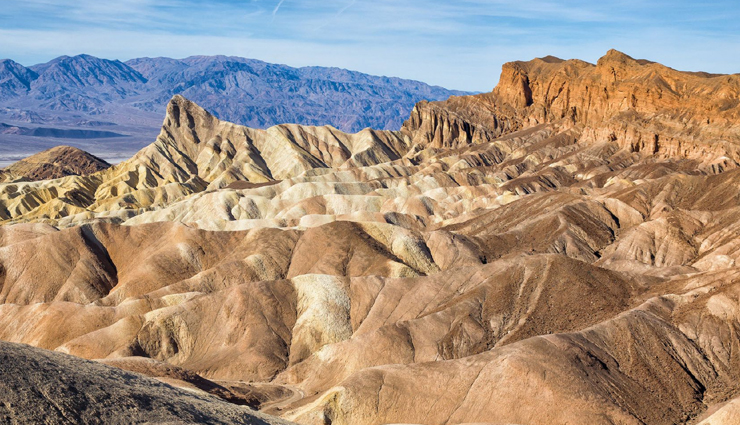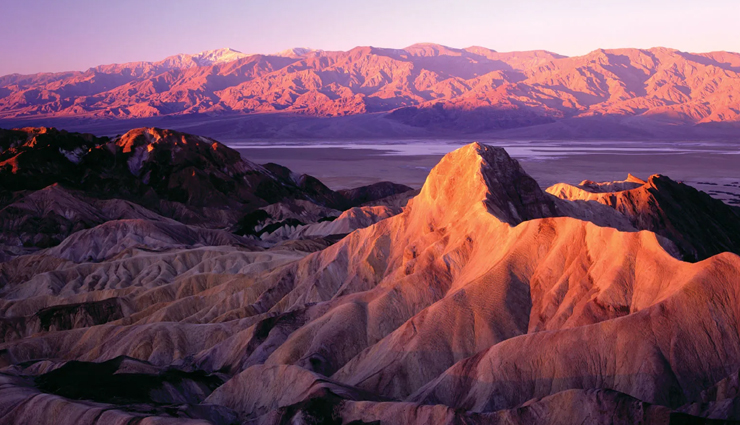
The landscape of Death Valley is characterized by its extreme aridness, unique geological formations, and vast salt flats. The valley's geological history has shaped its captivating features, including towering sand dunes, dramatic canyons, and rugged mountain ranges. Zabriskie Point, Dante's View, and Mesquite Flat Sand Dunes are some of the prominent attractions that showcase the area's geological wonders.
In addition to its geological significance, Death Valley is also known for its extreme climate. During the summer months, temperatures can soar to astonishing heights, often exceeding 120°F (49°C), making it one of the hottest places in the world. The unique climate and arid conditions have led to the creation of unusual desert adaptations among the flora and fauna that manage to survive in this harsh environment.

While its name might evoke thoughts of desolation, Death Valley's beauty and unique features have made it an intriguing destination for adventurers, nature enthusiasts, and those seeking to experience the extremes of our planet's natural wonders.
In addition to hosting one of the Earth's most challenging environments, Death Valley presents captivating landscapes, opportunities for stargazing, and a distinctive array of flora and fauna. It's no surprise that despite its status as the hottest location on the planet, Death Valley attracts tourists year-round.
Situated in the southwestern part of California, USA, Death Valley is a desert region. Within this expanse lies Death Valley National Park, located 282 feet below sea level in the United States. Between April and October, the daytime temperatures in this area reach a scorching 100 degrees Fahrenheit, only to plummet to 70 degrees at night.
The national park, also referred to as Furnace Creek, has once again garnered attention due to its recent temperature reading of over 131 degrees Fahrenheit. This reading marked the highest temperature ever recorded globally. Consequently, visitors have been making their way to Death Valley to commemorate this world record.
Amidst all the buzz surrounding Death Valley, we've taken the initiative to provide you with answers to the most commonly asked questions.
Death Valley is famous for several compelling reasons:
# Extreme Environment: One of the primary factors contributing to Death Valley's fame is its extreme environment. It is one of the hottest places on Earth, with scorching temperatures that can reach well over 120°F (49°C) during the summer months. This extreme heat captures people's fascination and curiosity.
# Lowest Point in North America: Death Valley is home to Badwater Basin, the lowest point in North America, situated at 282 feet (86 meters) below sea level. This geographical feature adds to the area's uniqueness and draws attention from visitors interested in exploring diverse landscapes.
# Geological and Natural Diversity: The region's geological history has given rise to a variety of distinct formations, attracting geologists, scientists, and nature enthusiasts. From the mesmerizing Zabriskie Point to the fascinating Mesquite Flat Sand Dunes, Death Valley offers a wide array of geological wonders.
# Stargazing Opportunities: The remote location and clear skies of Death Valley make it an exceptional destination for stargazing and astronomy. The lack of light pollution allows visitors to observe a dazzling night sky, making it a haven for astronomers and star enthusiasts.
# World Records: The extreme temperatures recorded in Death Valley, including the highest reliably recorded temperature on Earth, have garnered attention globally. This has led to tourists and media coverage, further enhancing its fame.
# Tourist Attractions: Despite the harsh conditions, Death Valley offers numerous attractions, including the Devil's Golf Course, Dante's View, Artist's Palette, and more. These sites add to the allure of the area and encourage tourism.
# Movies and Pop Culture: Death Valley's unique and surreal landscapes have served as backdrops for various movies, TV shows, and commercials, contributing to its recognition in popular culture.
# Adventure and Challenge: The extreme environment of Death Valley presents a challenge for adventurers and outdoor enthusiasts. Hiking, off-roading, and exploring the wilderness offer a sense of accomplishment and adventure for those willing to brave the conditions.